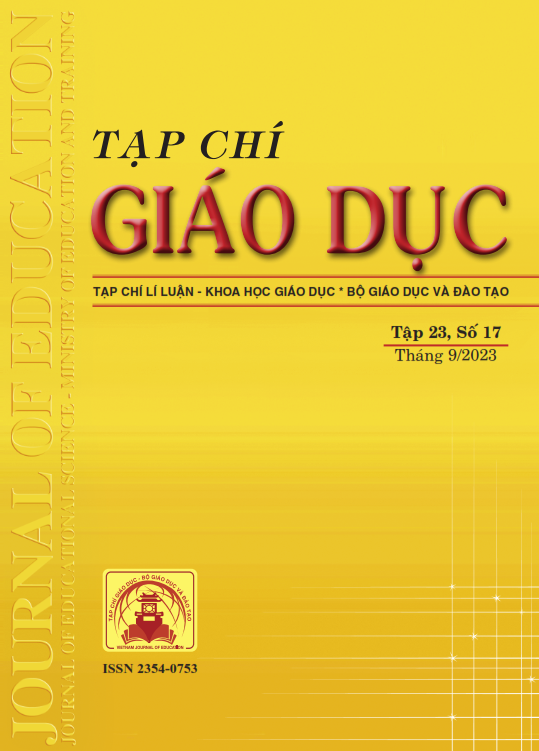Ứng dụng mô hình HEISQUAL để đánh giá chất lượng dạy học các học phần tiếng Anh cơ sở theo hình thức kết hợp tại Trường Đại học Ngoại thương
Tóm tắt
Blended learning has been deployed in many countries around the world with certain effects. This article was conducted to analyze how the HEISQUAL model was applied to assess the quality of teaching basic English courses with a blended learning approach through a survey on non-English majored students in these English language programs at Foreign Trade University in the academic year 2022-2023. Analytical methods used in the study include: data screening and filtration; descriptive statistics analysis; Cronbach's Alpha coefficient for scale reliability assessment; EFA factors analysis; correlation analysis; multiple regression analysis. The results of the regression analysis show that all components in the HEISQUAL model include: faculty, facilities, management and support; education program; safety and security; students' skills equally had a positive impact on the quality of basic English teaching in the form of blended learning. In particular, the teacher factor had the strongest impact on the teaching quality. The research results are an important basis for educational managers at Foreign Trade University to take specific measures to improve the quality of teaching basic English courses in the form of blended learning.
Tài liệu tham khảo
Abbas, J. (2020). HEISQUAL: A modern approach to measure service quality in higher education institutions. Studies in Educational Evaluation, 67, 100933.
Abdullah, F. (2006). Measuring service quality in higher education: HEdPERF versus SERVPERF. Marketing Intelligence & Planning, 24(1), 31-47.
Alammary, A., Sheard, J., & Carbone, A. (2014). Blended learning in higher education: Three different design approaches. Australasian Journal of Educational Technology, 30(4). https://doi.org/10.14742/ajet.693
Bauk, S., Šćepanović, S., & Kopp, M. (2014). Estimating students’ satisfaction with web based learning system in blended learning environment. Education Research International, 1-11. https://doi.org/10.1155/2014/731720
Bonk, C. J., & Graham, C. R. (2006). The handbook of blended learning: Global perspectives. Local Designs, 5.
Firdaus, A. (2005). The development of HEdPERF: A new measuring instrument of service quality for higher education sector. Paper presented at the Third Annual Discourse Power Resistance Conference: Global Issues. Local Solutions, University of Plymouth.
Gamage, D. T., Suwanabroma, J., Ueyama, T., Hada, S., & Sekikawa, E. (2008). The impact of quality assurance measures on student services at the Japanese and Thai private universities. Quality Assurance in Education, 16(2), 181-198.
Garrison, D. R., & Kanuka, H. (2004). Blended learning: Uncovering its transformative potential in higher education. The Internet and Higher Education, 7(2), 95-105.
Graham, C. R. (2006). Blended learning systems. The Handbook of Blended Learning: Global Perspectives, Local Designs, 1, 3-21.
Habib, M., Abbas, J., & Noman, R. (2019). Are human capital, intellectual property rights, and research and development expenditures really important for total factor productivity? An empirical analysis. International Journal of Social Economics, 46(6), 756-774.
Hair, J. F., Black, W. C., Babin, B. J., Anderson, R. E., & Tatham, R. L. (2006). Multivariate Data Analysis. New Jersey: Pearson University Press.
Harvey, L., & Green, D. (1993). Defining quality. Assessment & Evaluation in Higher Education, 18(1), 9-34.
Jain, R., Abhyankar, M., & Venugopal, G. (2013). Student engagement in a blended learning environment. International Journal of Advanced Computer Technology, 12(2), 378-384.
Kwek, C. L., Lau, T. C., & Tan, H. P. (2010). Education quality process model and its influence on students' perceived service quality. International Journal of Business and Management, 5(8), 154-165.
Latif, K. F., Latif, I., Farooq Sahibzada, U., & Ullah, M. (2019). In search of quality: Measuring higher education service quality (HiEduQual). Total Quality Management & Business Excellence, 30(7-8), 768-791.
O’Neill, M. A., & Palmer, A. (2004). Importance-performance analysis: A useful tool for directing continuous quality improvement in higher education. Quality Assurance in Education.
Schneider, M. (2002). Do School Facilities Affect Academic Outcomes?. National Clearinghouse for Educational Facilities, Washington, DC.
Silva, M., Ribeiro, M., Morgado, M., & Coelho, M. (2017). Teacher Training for CLIL in Higher Education: Challenges in Blended Learning. In ICERI2017 Proceedings (pp. 8005-8009). IATED.
Tải xuống
Đã Xuất bản
Cách trích dẫn
Số
Chuyên mục
Giấy phép

Tác phẩm này được cấp phép theo Ghi nhận tác giả của Creative Commons Giấy phép quốc tế 4.0 .












